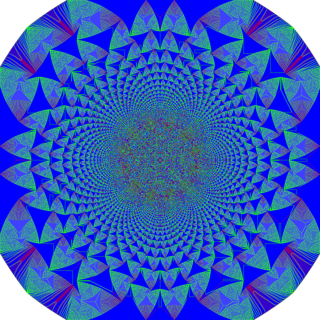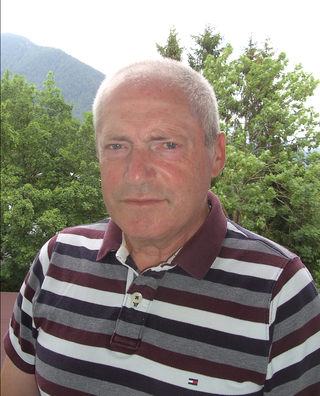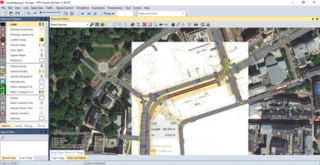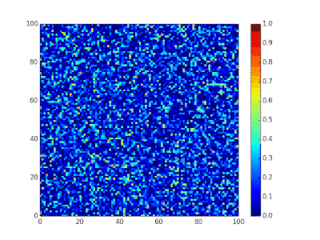Related Research Articles

Self-organized criticality (SOC) is a property of dynamical systems that have a critical point as an attractor. Their macroscopic behavior thus displays the spatial or temporal scale-invariance characteristic of the critical point of a phase transition, but without the need to tune control parameters to a precise value, because the system, effectively, tunes itself as it evolves towards criticality.

A crowd is as a group of people that have gathered for a common purpose or intent. Examples are a demonstration, a sports event, or a looting. A crowd may also simply be made up of many people going about their business in a busy area.

Peter V. Coveney is a British chemist who is Professor of Physical Chemistry, Honorary Professor of Computer Science, and the Director of the Centre for Computational Science (CCS) and Associate Director of the Advanced Research Computing Centre at University College London (UCL). He is also a Professor of Applied High Performance Computing at University of Amsterdam (UvA) and Professor Adjunct at the Yale School of Medicine, Yale University. He is a Fellow of the Royal Academy of Engineering and Member of Academia Europaea. Coveney is active in a broad area of interdisciplinary research including condensed matter physics and chemistry, materials science, as well as life and medical sciences in all of which high performance computing plays a major role. The citation about Coveney on his election as a FREng says: Coveney "has made outstanding contributions across a wide range of scientific and engineering fields, including physics, chemistry, chemical engineering, materials, computer science, high performance computing and biomedicine, much of it harnessing the power of supercomputing to conduct original research at unprecedented space and time scales. He has shown outstanding leadership across these fields, manifested through running multiple initiatives and multi-partner interdisciplinary grants, in the UK, Europe and the US. His achievements at national and international level in advocacy and enablement are exceptional".

A second-order cellular automaton is a type of reversible cellular automaton (CA) invented by Edward Fredkin where the state of a cell at time t depends not only on its neighborhood at time t − 1, but also on its state at time t − 2.

Boris S. Kerner is a German physicist and civil engineer who created three phase traffic theory. The three phase traffic theory is the framework for the description of empirical vehicular traffic states in three traffic phases: (i) free traffic flow (F), (ii) synchronized traffic flow (S), and (iii) wide moving jam (J). The synchronized traffic flow and wide moving jam phases belong to congested traffic.
Microscopic traffic flow models are a class of scientific models of vehicular traffic dynamics.

Rule 184 is a one-dimensional binary cellular automaton rule, notable for solving the majority problem as well as for its ability to simultaneously describe several, seemingly quite different, particle systems:
Superstatistics is a branch of statistical mechanics or statistical physics devoted to the study of non-linear and non-equilibrium systems. It is characterized by using the superposition of multiple differing statistical models to achieve the desired non-linearity. In terms of ordinary statistical ideas, this is equivalent to compounding the distributions of random variables and it may be considered a simple case of a doubly stochastic model.

PTV Vissim is a microscopic multi-modal traffic flow simulation software package developed by PTV Planung Transport Verkehr AG in Karlsruhe, Germany. It was first developed in 1992. The name is derived from "Verkehr In Städten - SIMulationsmodell".

In transportation infrastructure, a bidirectional traffic system divides travellers into two streams of traffic that flow in opposite directions.

Classic epidemic models of disease transmission are described in Compartmental models in epidemiology. Here we discuss the behavior when such models are simulated on a lattice. Lattice models, which were first explored in the context of cellular automata, act as good first approximations of more complex spatial configurations, although they do not reflect the heterogeneity of space. Lattice-based epidemic models can also be implemented as fixed agent-based models.

A reversible cellular automaton is a cellular automaton in which every configuration has a unique predecessor. That is, it is a regular grid of cells, each containing a state drawn from a finite set of states, with a rule for updating all cells simultaneously based on the states of their neighbors, such that the previous state of any cell before an update can be determined uniquely from the updated states of all the cells. The time-reversed dynamics of a reversible cellular automaton can always be described by another cellular automaton rule, possibly on a much larger neighborhood.
A stock correlation network is a type of financial network based on stock price correlation used for observing, analyzing and predicting the stock market dynamics.
Stochastic cellular automata or probabilistic cellular automata (PCA) or random cellular automata or locally interacting Markov chains are an important extension of cellular automaton. Cellular automata are a discrete-time dynamical system of interacting entities, whose state is discrete.
Physics of financial markets is a non-orthodox economics discipline that studies financial markets as physical systems. It seeks to understand the nature of financial processes and phenomena by employing the scientific method and avoiding beliefs, unverifiable assumptions and immeasurable notions, not uncommon to economic disciplines.
Surajit Sen is a physicist who works on theoretical and computational problems in non-equilibrium statistical physics and in nonlinear dynamics of many body systems. He holds a Ph.D in physics from The University of Georgia (1990) where he studied with M. Howard Lee. He is also interested in applying physics to study problems of relevance in a societal context. He is a professor of physics at the State University of New York, Buffalo. Much of Sen's recent work can be found in his RUSA lecture at Bharatidasan University.
In chemical kinetics, the Aquilanti–Mundim deformed Arrhenius model is a generalization of the standard Arrhenius law.

Erica Kuligowski is an american social research scientist investigating human behavior during emergencies and the performance of evacuation models in disasters. She currently works at RMIT university in Melbourne (Australia). Kuligowski used to work the Engineering Lab of the National Institute of Standards and Technology conducting research on several fire disasters including the NIST Hurricane Maria Project.
The KBD algorithm is a cluster update algorithm designed for the fully frustrated Ising model in two dimensions, or more generally any two dimensional spin glass with frustrated plaquettes arranged in a checkered pattern. It is discovered in 1990 by Daniel Kandel, Radel Ben-Av, and Eytan Domany, and generalized by P. D. Coddington and L. Han in 1994. It is the inspiration for cluster algorithms used in quantum monte carlo simulations.

Ruggiero Lovreglio is an Italian academic based in Auckland, New Zealand. He is an associate professor at Massey University and a Rutherford Discovery Fellow for Royal Society Te Apārangi. His research is focused on large-scale and small-scale evacuation dynamics and safety training using emerging technologies, such as virtual reality and augmented reality.
References
- ↑ Kuligowski, Erica D.; Peacock, Richard D.; Hoskins, Bryan L. (2010-11-01). "A Review of Building Evacuation Models, 2nd Edition". NIST.
- ↑ Gwynne, S.; Galea Ed Galea, E. R.; Owen, M.; Lawrence, P. J.; Filippidis, L. (1999-11-01). "A review of the methodologies used in the computer simulation of evacuation from the built environment". Building and Environment. 34 (6): 741–749. doi:10.1016/S0360-1323(98)00057-2. ISSN 0360-1323.
- ↑ Haghani, Milad; Lovreglio, Ruggiero; Button, Mary Langridge; Ronchi, Enrico; Kuligowski, Erica (2024-03-01). "Human behaviour in fire: Knowledge foundation and temporal evolution". Fire Safety Journal. 144: 104085. doi: 10.1016/j.firesaf.2023.104085 . ISSN 0379-7112.
- ↑ Lovreglio, Ruggiero; Ronchi, Enrico; Kinsey, Michael J. (2020-05-01). "An Online Survey of Pedestrian Evacuation Model Usage and Users". Fire Technology. 56 (3): 1133–1153. doi: 10.1007/s10694-019-00923-8 . ISSN 1572-8099.
- ↑ "Pedestrian and Evacuation Dynamics | Collective Dynamics". collective-dynamics.eu. Retrieved 2024-02-03.
- ↑ "Human Behaviour in Fire Symposium 2015". www.intersciencecomms.co.uk. Retrieved 2024-02-03.
- ↑ Kuligowski, Erica D. (2016), Hurley, Morgan J.; Gottuk, Daniel; Hall, John R.; Harada, Kazunori (eds.), "Computer Evacuation Models for Buildings", SFPE Handbook of Fire Protection Engineering, New York, NY: Springer, pp. 2152–2180, doi:10.1007/978-1-4939-2565-0_60, ISBN 978-1-4939-2565-0 , retrieved 2024-02-03
- ↑ Burstedde, C; Klauck, K; Schadschneider, A; Zittartz, J (2001-06-15). "Simulation of pedestrian dynamics using a two-dimensional cellular automaton". Physica A: Statistical Mechanics and its Applications. 295 (3): 507–525. arXiv: cond-mat/0102397 . doi:10.1016/S0378-4371(01)00141-8. ISSN 0378-4371.
- ↑ Kirchner, Ansgar; Schadschneider, Andreas (2002-09-01). "Simulation of evacuation processes using a bionics-inspired cellular automaton model for pedestrian dynamics". Physica A: Statistical Mechanics and its Applications. 312 (1): 260–276. arXiv: cond-mat/0203461 . doi:10.1016/S0378-4371(02)00857-9. ISSN 0378-4371.
- ↑ Lovreglio, Ruggiero; Ronchi, Enrico; Nilsson, Daniel (2015-11-15). "Calibrating floor field cellular automaton models for pedestrian dynamics by using likelihood function optimization". Physica A: Statistical Mechanics and its Applications. 438: 308–320. doi:10.1016/j.physa.2015.06.040. ISSN 0378-4371.
- ↑ Meyer-König, T., Klüpfel, H., & Schreckenberg, M. (2002). Assessment and analysis of evacuation processes on passenger ships by microscopic simulation. Schreckenberg and Sharma [2], 297-302.
- ↑ Blue, Victor; Adler, Jeffrey (1999-01-01). "Cellular Automata Microsimulation of Bidirectional Pedestrian Flows". Transportation Research Record: Journal of the Transportation Research Board. 1678: 135–141. doi:10.3141/1678-17. ISSN 0361-1981. S2CID 110675891.
- ↑ Kirchner, Ansgar; Schadschneider, Andreas (2002). "Simulation of evacuation processes using a bionics-inspired cellular automaton model for pedestrian dynamics". Physica A: Statistical Mechanics and Its Applications. 312 (1–2): 260–276. arXiv: cond-mat/0203461 . Bibcode:2002PhyA..312..260K. doi:10.1016/s0378-4371(02)00857-9. S2CID 119465496.
- ↑ Wirth, Ervin; Szabó, György (2017-06-14). "Overlap-avoiding Tickmodel: an Agent- and GIS-Based Method for Evacuation Simulations". Periodica Polytechnica Civil Engineering. 62 (1): 72–79. doi: 10.3311/PPci.10823 . ISSN 1587-3773.
- ↑ Helbing, Dirk (1995). "Social force model for pedestrian dynamics". Physical Review E. 51 (5): 4282–4286. arXiv: cond-mat/9805244 . Bibcode:1995PhRvE..51.4282H. doi:10.1103/physreve.51.4282. PMID 9963139. S2CID 29333691.
- ↑ Izquierdo, J.; Montalvo, I.; Pérez, R.; Fuertes, V.S. (2009). "Forecasting pedestrian evacuation times by using swarm intelligence". Physica A: Statistical Mechanics and Its Applications. 388 (7): 1213–1220. Bibcode:2009PhyA..388.1213I. doi:10.1016/j.physa.2008.12.008.
- ↑ Hughes, Roger L. (2003-01-01). "The flow of human crowds". Annual Review of Fluid Mechanics. 35 (1): 169–182. Bibcode:2003AnRFM..35..169H. doi:10.1146/annurev.fluid.35.101101.161136. ISSN 0066-4189.
- ↑ Gwynne, Steven M. V.; Rosenbaum, Eric R. (2016), Hurley, Morgan J.; Gottuk, Daniel; Hall, John R.; Harada, Kazunori (eds.), "Employing the Hydraulic Model in Assessing Emergency Movement", SFPE Handbook of Fire Protection Engineering, New York, NY: Springer, pp. 2115–2151, doi:10.1007/978-1-4939-2565-0_59, ISBN 978-1-4939-2565-0 , retrieved 2024-02-03
- ↑ Evacuation Modelling using FDS+Evac, PathFinder, STEPS and Unity3D , retrieved 2024-02-03
Literature
- A. Schadschneider, W. Klingsch, H. Klüpfel, T. Kretz, C. Rogsch, and A. Seyfried. Evacuation Dynamics: Empirical Results, Modeling and Applications. In R.A. Meyers, editor, Encyclopedia of Complexity and System Science. Springer, Berlin Heidelberg New York, 2009. (to be published in April 2009, available at arXiv:0802.1620v1).
- Lord J, Meacham B, Moore A, Fahy R, Proulx G (2005). Guide for evaluating the predictive capabilities of computer egress models, NIST Report GCR 06-886. http://www.fire.nist.gov/bfrlpubs/fire05/PDF/f05156.pdf Archived 2010-05-29 at the Wayback Machine
- E. Ronchi, P. Colonna, J. Capote, D. Alvear, N. Berloco, A. Cuesta. The evaluation of different evacuation models for road tunnel safety analyses. Tunnelling and Underground Space Technology Vol. 30, July 2012, pp74–84. doi : 10.1016/j.tust.2012.02.008
- Kuligowski ED, Peacock RD, Hoskins, BL (2010). A Review of Building Evacuation Models NIST, Fire Research Division. 2nd edition. Technical Note 1680 Washington, US.
- International Maritime Organization (2007). Guidelines for Evacuation Analyses for New and Existing Passenger Ships, MSC/Circ.1238, International Maritime Organization, London, UK.
- R. Lovreglio, E. Ronchi, M. J. Kinsey (2019). An online survey of pedestrian evacuation model usage and users. Fire Technology. https://doi.org/10.1007/s10694-019-00923-8